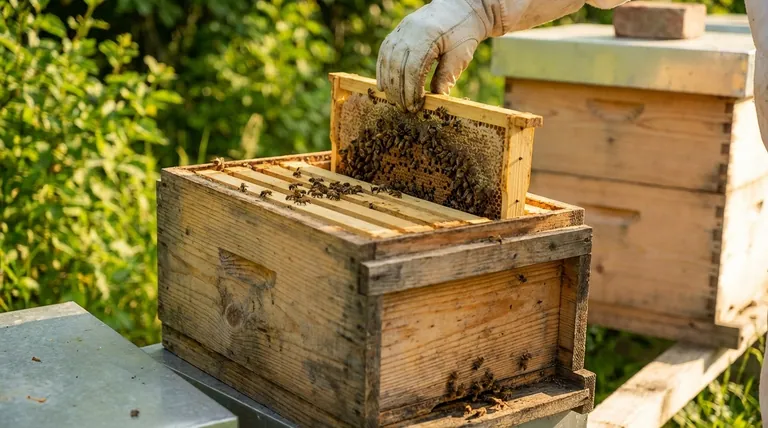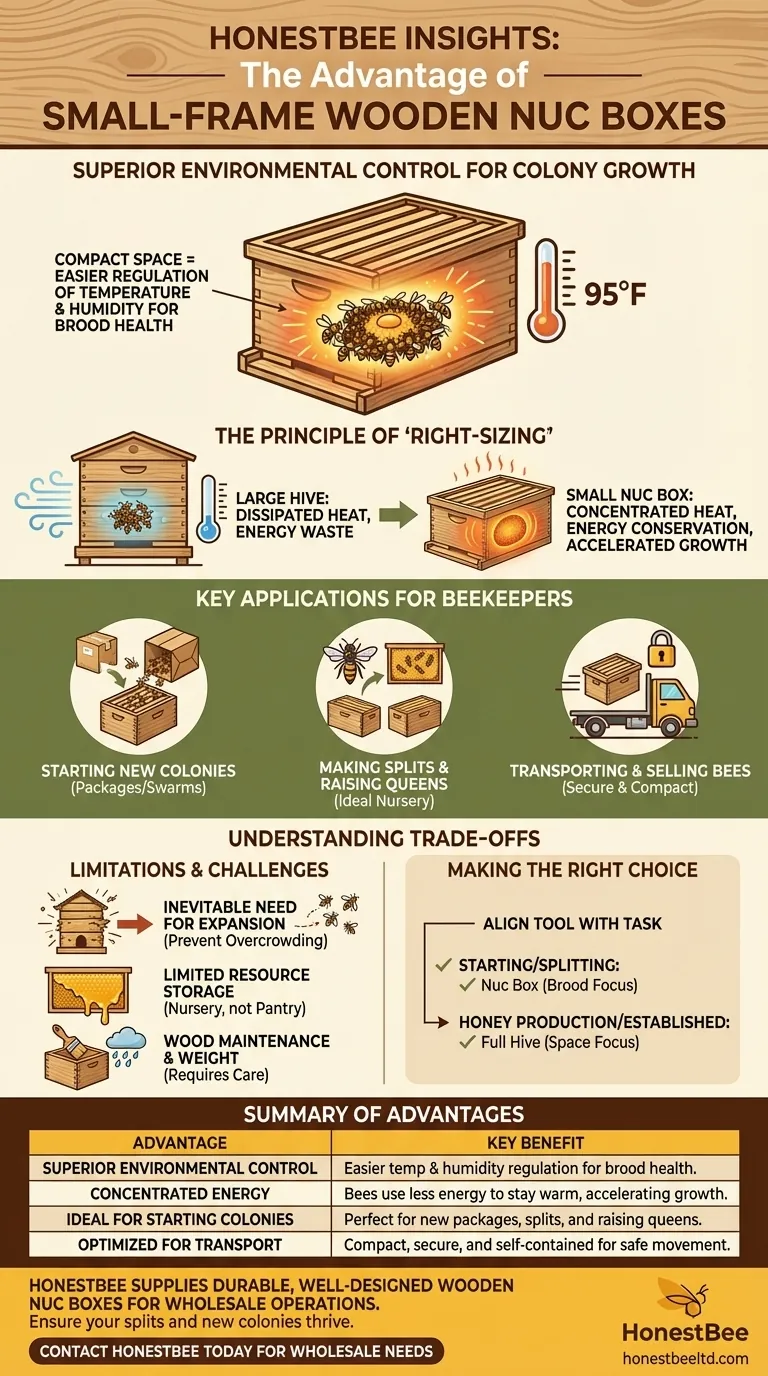The primary advantage of a smaller frame count in a wooden nucleus (nuc) box is superior environmental control. This compact space allows a small or developing bee colony to more easily regulate the internal temperature and humidity, which is absolutely critical for the health and development of their brood.
The core principle is simple: matching the size of the hive to the size of the colony. A small nuc box minimizes wasted space, allowing the bees to concentrate their energy on what matters most—raising the next generation and expanding the workforce.

The Principle of "Right-Sizing" a Bee Colony
A bee colony is a superorganism that functions best within specific environmental parameters. Providing a space that is too large for a small colony is inefficient and can be detrimental to its growth.
Concentrating Heat and Energy
Bees must maintain their brood nest at a remarkably consistent temperature, typically around 95°F (35°C), for larvae to develop properly.
In a large, cavernous hive, the heat generated by the cluster of bees dissipates quickly. This forces the colony to consume significant amounts of honey and expend precious energy just to stay warm.
A nuc box, with its smaller volume, acts like a well-insulated incubator. It allows the colony's natural heat to be retained, dramatically reducing their energy burden.
Optimizing Brood Rearing
Stable temperature and humidity are the most important factors for successful brood rearing. Fluctuations can lead to chilled brood, disease, and a slower rate of population growth.
The controlled environment of a nuc box creates the ideal nursery. This stability directly translates to healthier bees and a faster population buildup, which is the primary goal for any new colony.
Key Applications Driven by a Smaller Size
The nuc box's design makes it a specialized and indispensable tool for beekeepers, far beyond just being a "small hive."
Starting New Colonies
Nuc boxes are the standard for housing newly installed bee packages or captured swarms. The confined space prevents the small population from feeling overwhelmed and helps them establish their brood nest quickly.
Making Splits and Raising Queens
When a beekeeper splits a large hive to create a new one, a nuc box is the perfect starting home. Its controlled environment gives the new queen and small workforce the best possible chance of success.
Transporting and Selling Bees
Due to their compact, self-contained nature, nuc boxes are the industry standard for selling and transporting small, established colonies. They are easy to handle, secure, and provide a safe environment for the bees during transit.
Understanding the Trade-offs
While highly effective for its purpose, the small size of a nuc box is also its primary limitation. It is a tool for a specific phase of a colony's life, not a permanent home.
The Inevitable Need for Expansion
A nuc is designed for growth, meaning a successful colony will quickly outgrow it. The beekeeper must be vigilant and ready to move the colony into a full-sized hive.
Failure to provide more space in a timely manner will lead to overcrowding, which is a primary trigger for the colony to swarm.
Limited Resource Storage
A nuc box provides enough space for the bees' immediate needs but offers virtually no room for surplus honey storage. It is a nursery, not a pantry or a production facility.
The Choice of Wood
Wood is a traditional, durable, and sustainable material for hive construction. It offers good insulation and is easily customized.
However, it also requires maintenance, such as painting, to protect it from the elements. Wooden nucs can also be significantly heavier than alternatives like high-density polystyrene.
Making the Right Choice for Your Goal
Using equipment correctly is about aligning the tool with the task at hand. The nuc box is a perfect example of a specialized tool for colony establishment.
- If your primary focus is starting a new colony, making a split, or raising a queen: The small frame count of a nuc box provides the ideal, energy-efficient environment for brood development.
- If your primary focus is honey production or managing a large, established colony: You must move the colony from a nuc into a full-sized hive to provide adequate space for population growth and resource storage.
Ultimately, understanding the advantage of a nuc box is understanding that a bee colony's health depends on giving it the right amount of space at the right time.
Summary Table:
| Advantage | Key Benefit |
|---|---|
| Superior Environmental Control | Easier temperature & humidity regulation for brood health. |
| Concentrated Energy | Bees use less energy to stay warm, accelerating growth. |
| Ideal for Starting Colonies | Perfect for new packages, splits, and raising queens. |
| Optimized for Transport | Compact, secure, and self-contained for safe movement. |
Ready to give your new colonies the best start? For commercial apiaries and distributors, the right equipment is the foundation of success. HONESTBEE supplies durable, well-designed wooden nuc boxes and a full range of beekeeping supplies through our wholesale-focused operations. Ensure your splits and new colonies thrive with equipment built for performance.
Contact HONESTBEE today to discuss your wholesale needs and optimize your beekeeping operation.
Visual Guide

Related Products
- Plastic Transporting Bee Packages and Nuc Boxes for Beekeeping
- Automatic Heat Preservation 6 Frame Pro Nuc Box for Honey Bee Queen Mating
- Portable Bee Mating Hive Boxes Mini Mating Nucs 8 Frames for Queen Rearing
- 4 Frame Plastic Nuc Boxes for Beekeeping Bee Nuc Box
- Styrofoam Mini Mating Nuc Box with Frames Feeder Styrofoam Bee Hives 3 Frame Nuc Box
People Also Ask
- What is the method for making several smaller nuclei from a single colony? Accelerate Apiary Growth with the Split Technique
- Will bees naturally come to a bee box? How to Successfully Attract Your First Swarm
- What are the common sizes and types of nuc boxes? A Guide to the Perfect Fit for Your Apiary
- What are the benefits of starting a new bee colony in a nuc box? Boost Colony Success with Efficient Beekeeping
- What are the two main ways to obtain a queen bee when starting a new hive? Choose the Right Start for Your Apiary



















